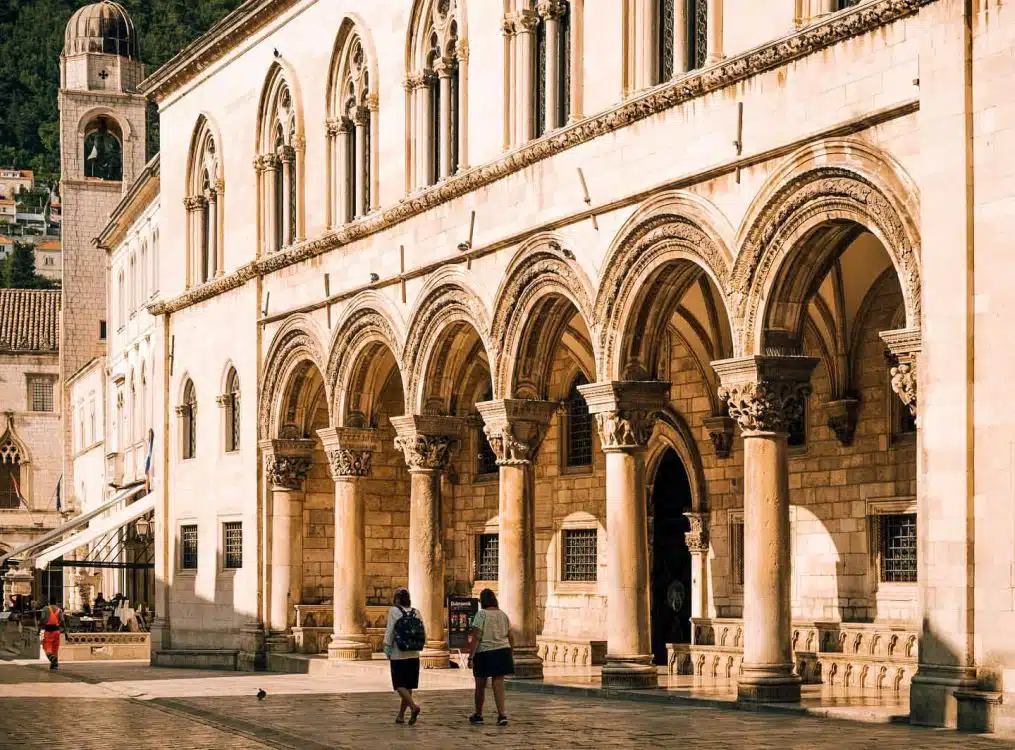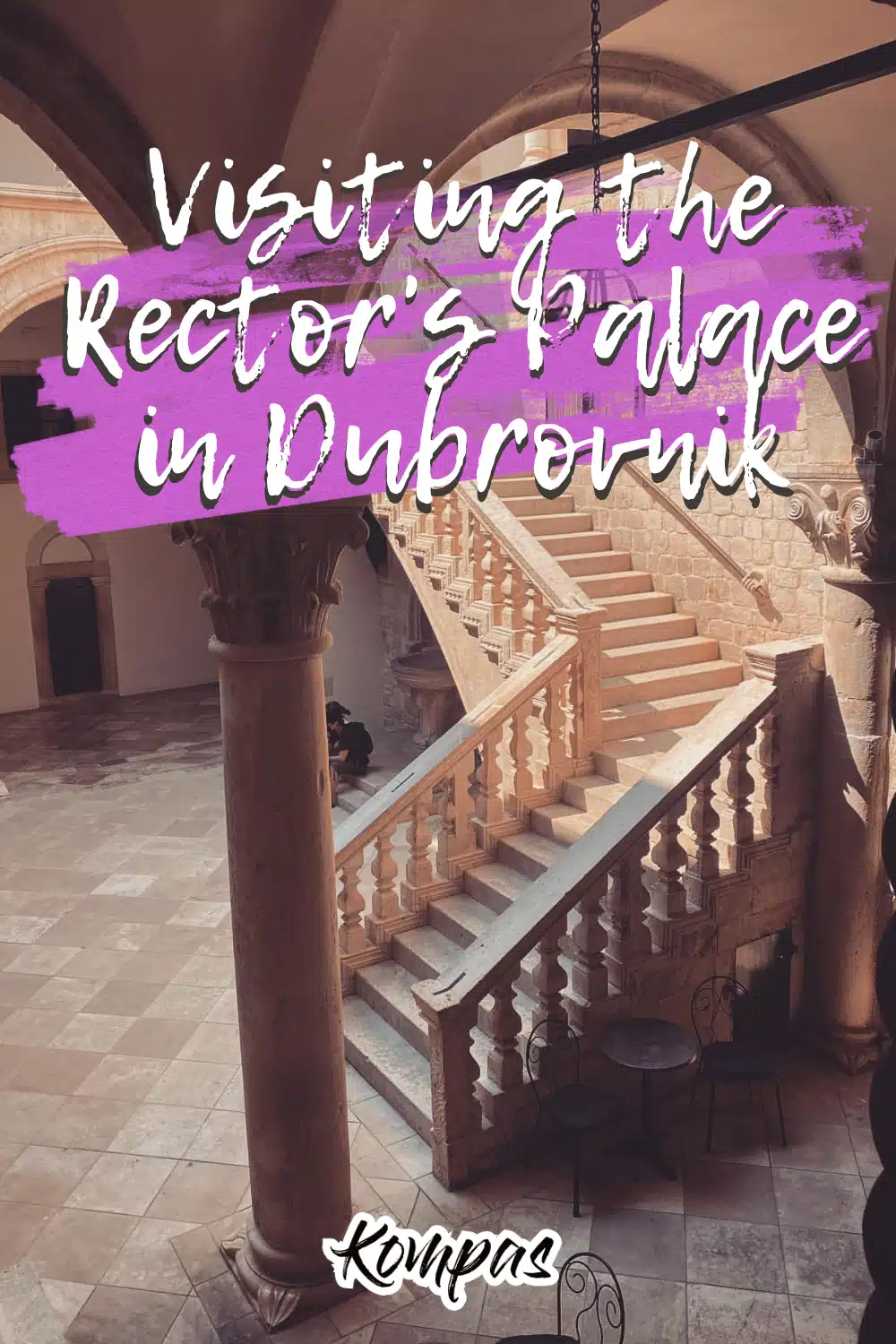The Dubrovnik Cultural-Historical Museum is located in the beautiful historical building - the Rector's Palace - which is worth a visit in itself. The Palace reflects the incredible history of the Old Town. My top choice for museums in Dubrovnik.
A must-see for travelers in Dubrovnik!
Plenty of exhibits offer a fascinating insight into how the city worked centuries ago. You can also learn about the city's laws and politics and how they have changed over time. Fascinating exhibits are spread over the ground floor, mezzanine, and first floor, including an inner courtyard and a dungeon on the ground floor.
The upper floors boast an array of artworks, artifacts, weapons, armor, coins, old documents, and gorgeous furniture. I was particularly intrigued by the rooms full of safes and strongboxes with complex lock designs and elaborate ornamentation.
It's included in the Dubrovnik Pass, which I strongly suggest you buy if you plan on visiting the City Walls. And let's be real. Who visits Dubrovnik and doesn't go on the Walls? So there's no excuse not to go!
Tip: If you're looking to explore everything you can, the Dubrovnik Museums pass is a great alternative to Dubrovnik Pass to visit the city museums. For just €20, you can access nine different museums over seven days.
Rector's Palace
The Rector's Palace has a fascinating history. It was the seat of the government and residence of the Prince (Rector) of the Dubrovnik Republic.
Did You Know: The history of Dubrovnik as an independent city-state situated on the east coast of the Adriatic lasted until 31st January 1808, when a decree issued by Napoleon's army dissolved the centuries-old Dubrovnik Republic.
As the head of the executive branch of government (Small Council - Consilium Minus), the Rector of the Dubrovnik Republic was elected for one month of office. Foreign affairs were managed by the Senate (the Council of the Rogatory - Consilium Rogatorum), while the legislature was the responsibility of the Parliament, which comprised all members of the Dubrovnik nobility from the age of 18 (Great Council - Consilium Maius).
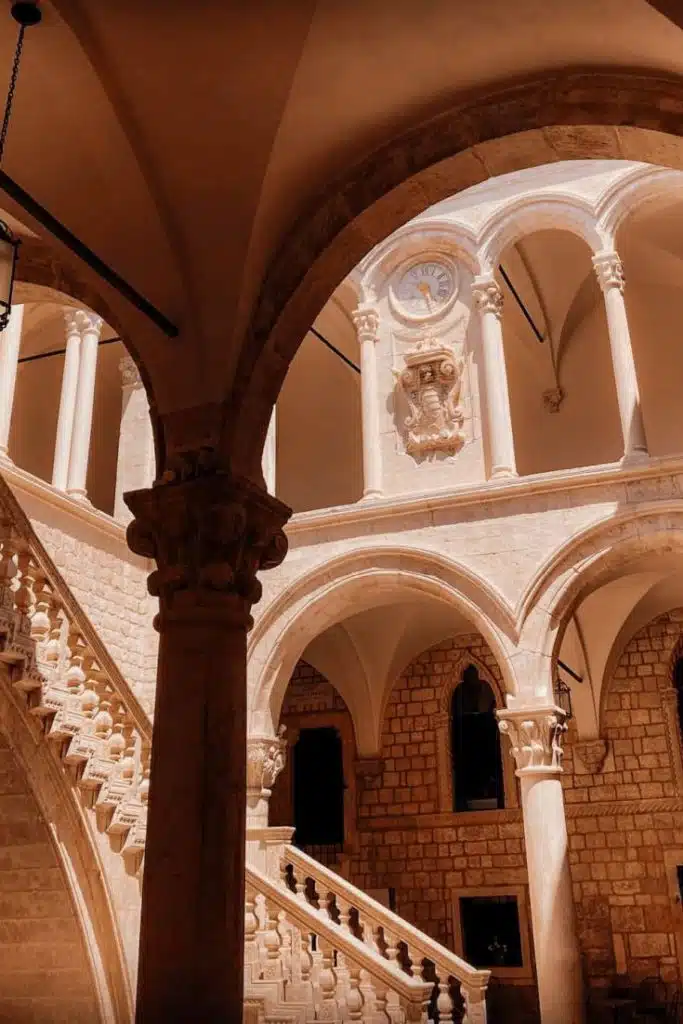
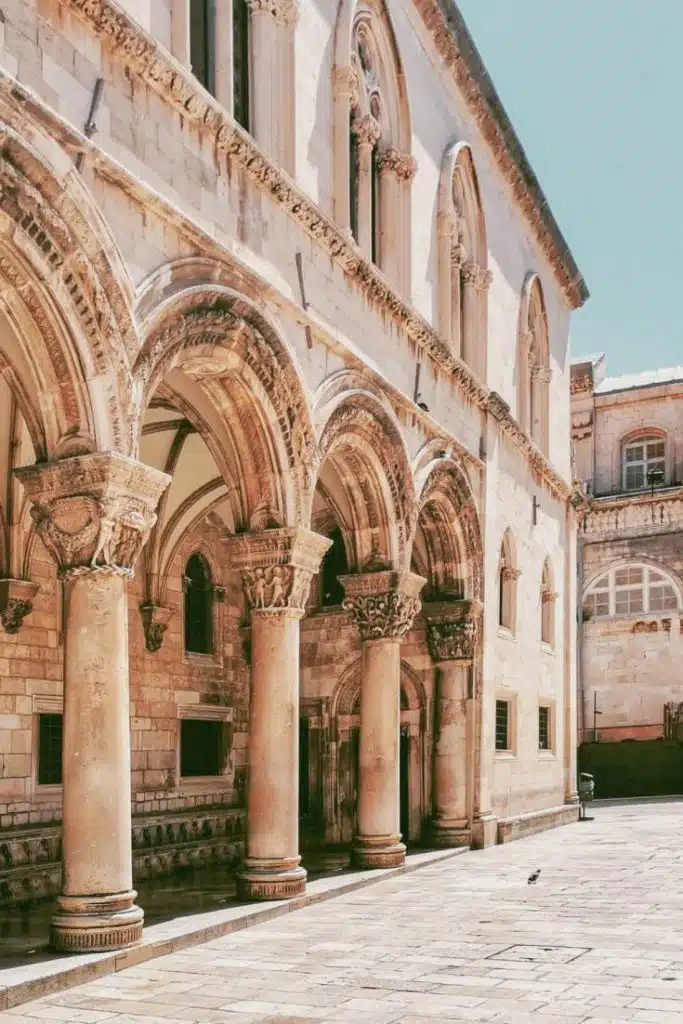
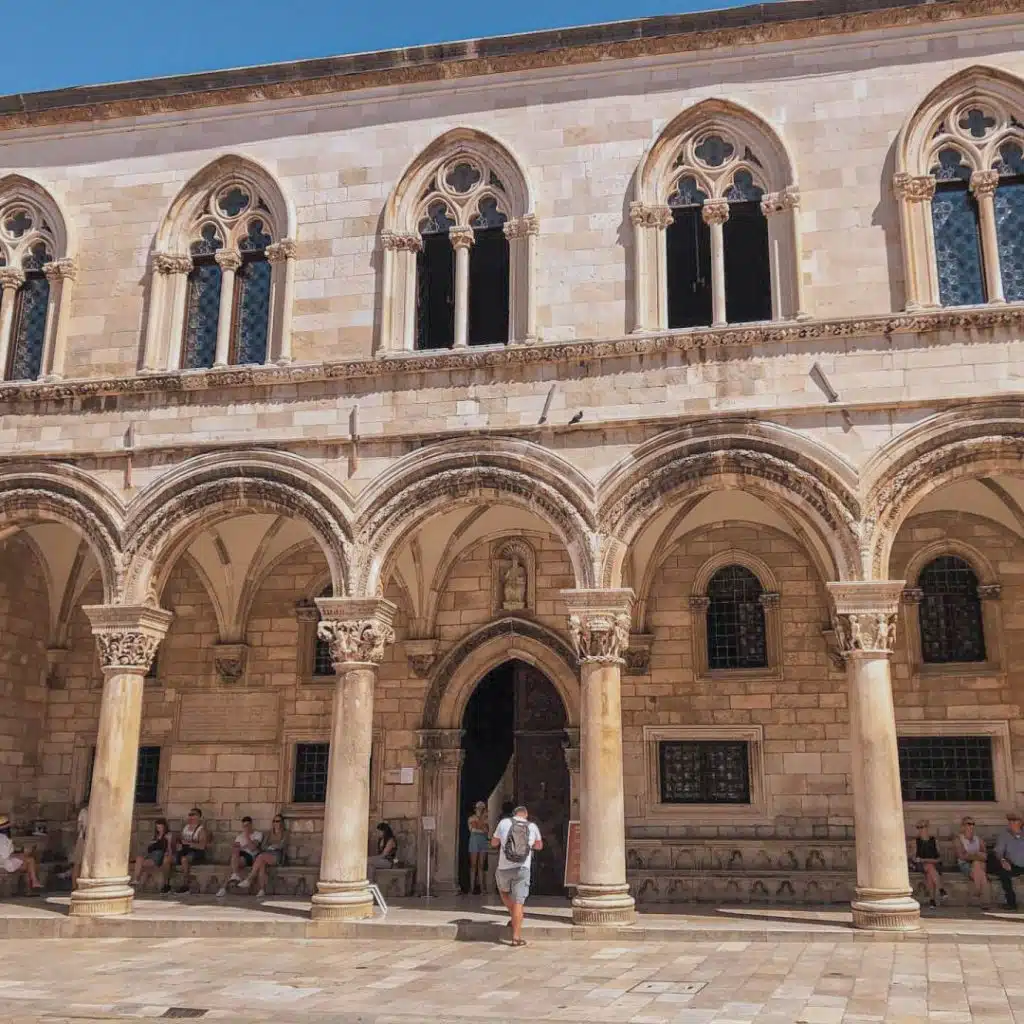
According to records dating from the 13th century, a "castellum" surrounded by four corner towers was once located on the site on which the Rector's Palace is today. The reconstruction of the fortress into the palace took place in the 14th century.
Interesting: The palace was modeled on the Roman imperial royal residences and the Venetian palaces (in its middle section, the main façade opens into a portico with two side towers).
The palace received its present form (a single-story building with four wings closing the courtyard - an entrance with a small mezzanine floor gallery and a large floor gallery) in the mid-15th century during the reconstruction following the demolition of the old Rector's Palace in the gunpowder explosion of 1435.
The new Rector's Palace was built in the late-Gothic style by Onofrio de la Cava, an architect from Naples who also created the waterworks and two public fountains in Dubrovnik (1435-1440). The statue on the building is probably the work of Pietro di Martino, an architect, and sculptor from Milan.
Interesting: The building was hit by more major damage in 1463 due to another gunpowder explosion. It was also severly damaged again in the great fire of 1667, which ravaged the town.
The reconstruction of the Rector's Palace after the explosion of 1463 included the work of two renowned artists, M. Michelozzo from Florence and Juraj Dalmatinac from Zadar.
But, unfortunately, the Palace was not rebuilt according to Michelozzo's design. Many local craftsmen (Radko Ivančić, Juraj Dalmatinac, Vukac Bogosalić, and Radoje Pribilović) worked on completing it.
The new style of architecture - the Renaissance - left its mark on the building only in small details. At the same time, the façade towers were made shorter to be leveled with the middle section of the building. As a result, the vertical Gothic form gave way to the pronounced horizontal layout of the Renaissance style.
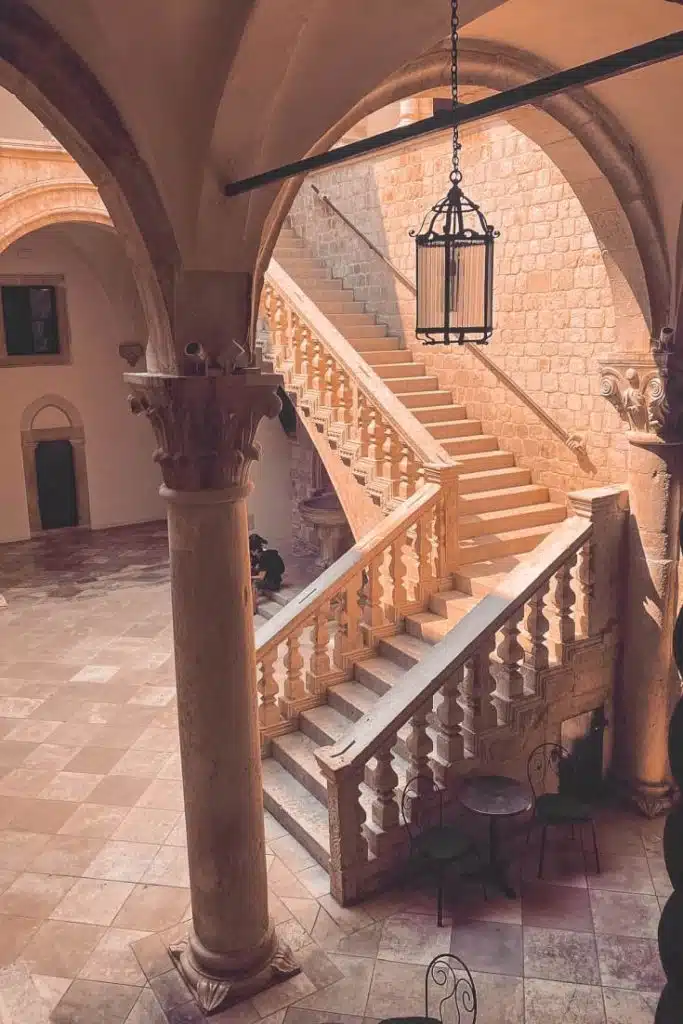
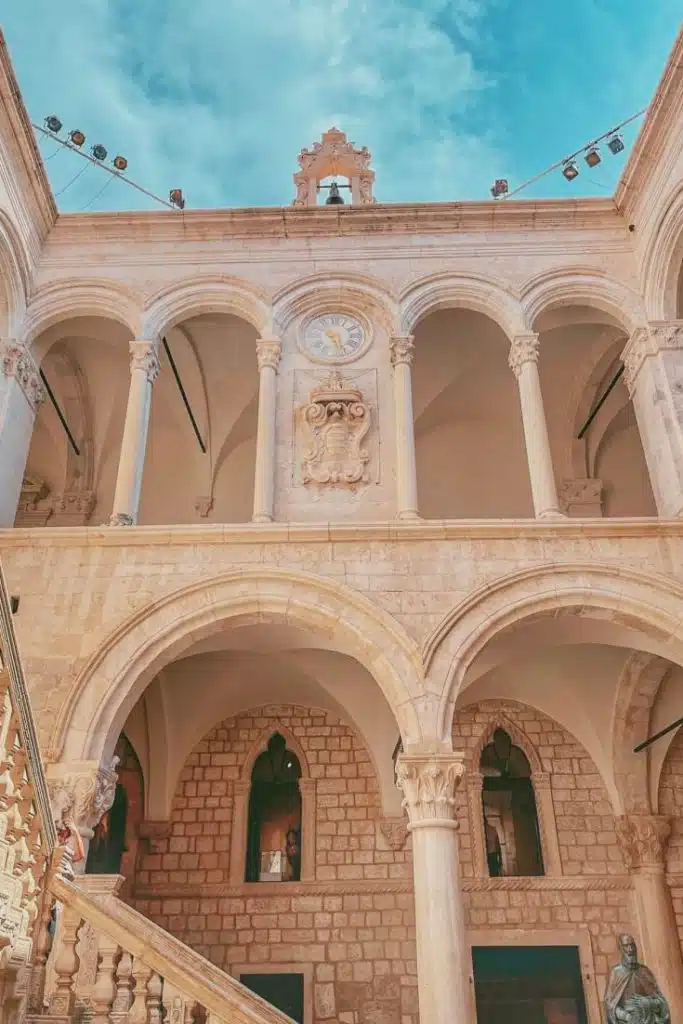
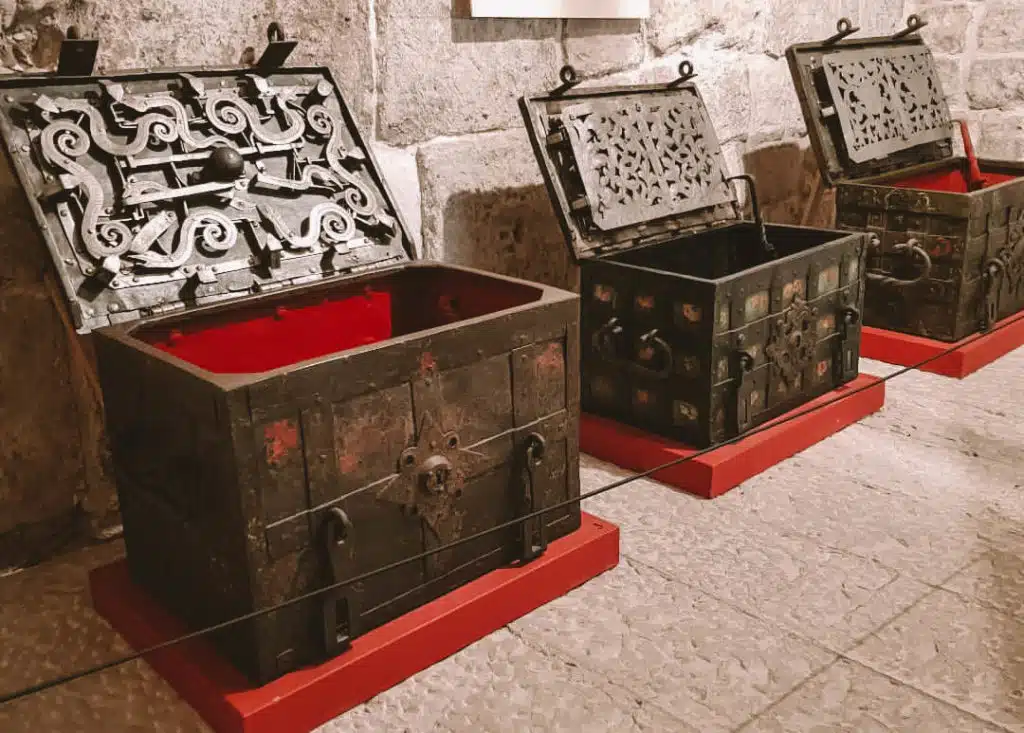
The disastrous earthquake of 1667 mostly damaged the building's interior, namely the columns and arches of the courtyard and the galleries. It was reconstructed towards the end of the 17th century in Gothic style, with some Baroque elements.
The last reconstruction of the building took place in 1982 following the earthquake of 1979.
Did You Know: In the courtyard of the Palace is the statue of Miho Pracat, a wealthy and renowned sailor who left all his fortunes to the Republic. It is the only monument ever erected to a Dubrovnik citizen during the Republic, even though the Republic did not like to give importance to any individual, only the collective.
In the Dubrovnik Republic, the ground floor of the Palace housed the state offices, the notary's office, the law court, and the jail. The old armory and the Small Council hall were situated on the mezzanine floor of the southern wing. The eastern wing of the mezzanine floor housed the court guard.
Tips: Rector's Palace courtyard is a frequent concert hall. Dubrovnik symphony orchestra and various world classical musicians play for an intimate crowd in this acoustic setting. Snag some concet tickets during the Dubrovnik Summer Festival to experience Rector's Palace in an almost private atmosphere.
A large flight of stairs lead from the atrium to the Great Council hall (pulled down in 1863), whose door bore the inscription "Obliti Privatorum - Publica Curata" (forget private affairs - look after the public causes), and the rooms for functions and the Rector's apartment consisting of a study, a central area, and a bedroom.
Next to the Rector's rooms was the court chapel. The vestibule in front of the hall accommodated the guard of honor during audiences of foreign diplomats with the Rector.
Interesting: Rector's Palace shortly appeared in the Game of Thrones TV show. The Palaces' atrium staircase is the setting for a couple of scenes in the show's second season, acting as the city of Quarth. It's the place where Daenerys Targaryen asks the Spice King of Quarth if he is willing to give her ships to take her army across the Narrow Sea and conquer back Westeros.
These rooms today feature period furniture, numerous antique objects, and paintings. The apartment of the prison warden and the Senate hall were located in the eastern wing of the first floor facing the sea.
Dubrovnik Cultural Historical Museum
The museum holds a significant collection of cultural, historical, and artistic objects, with around 20,000 items on display. It spans centuries of Dubrovnik history and culture, from the mid-14th century to the early 20th century.
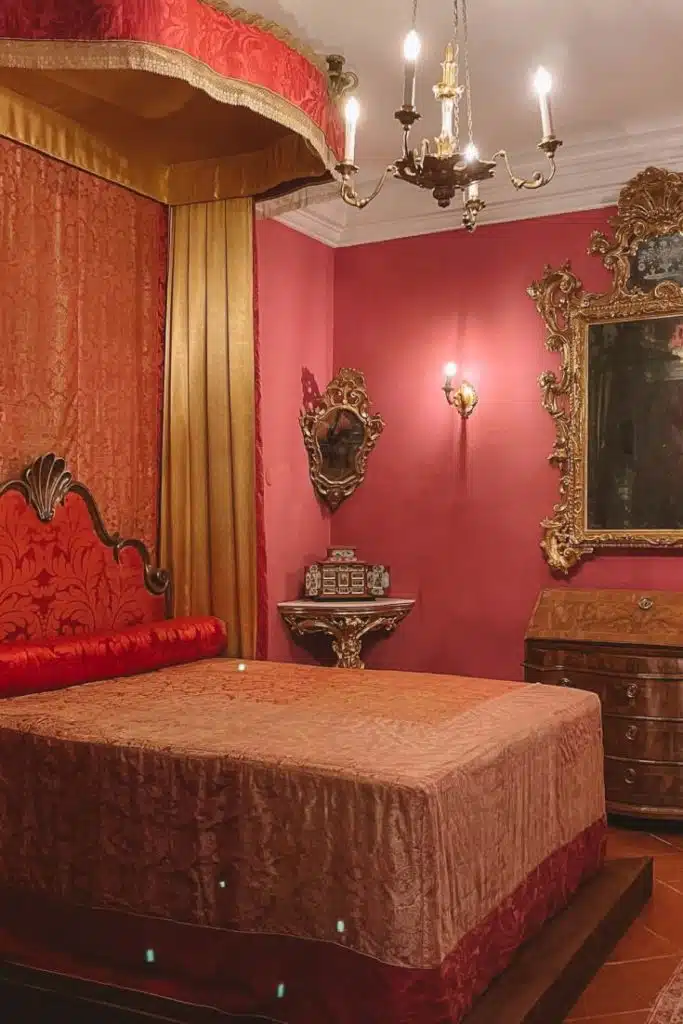
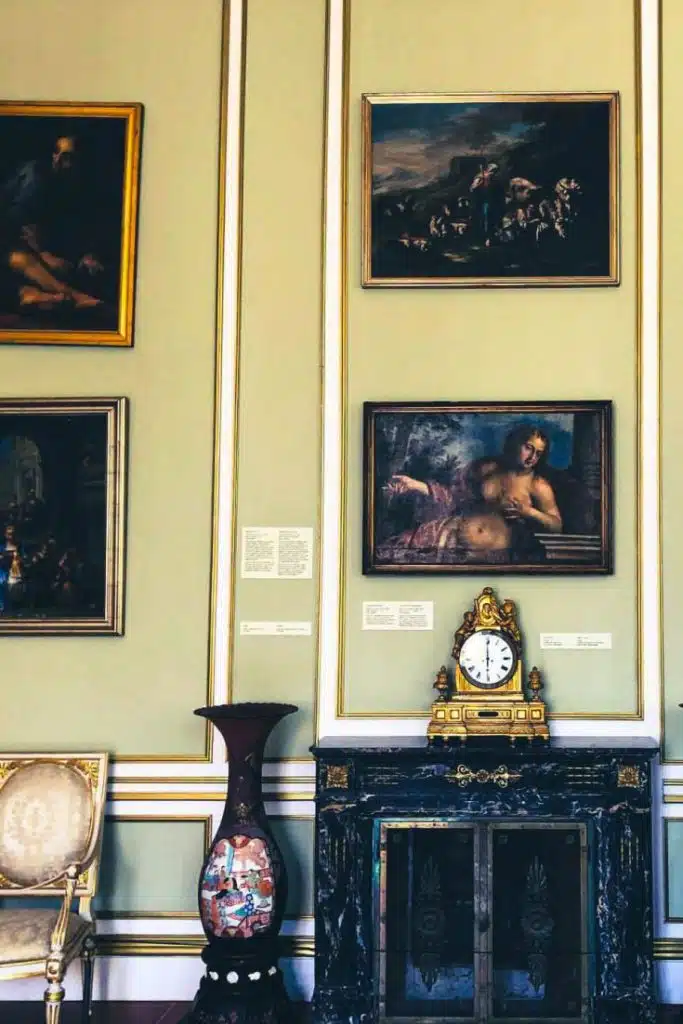
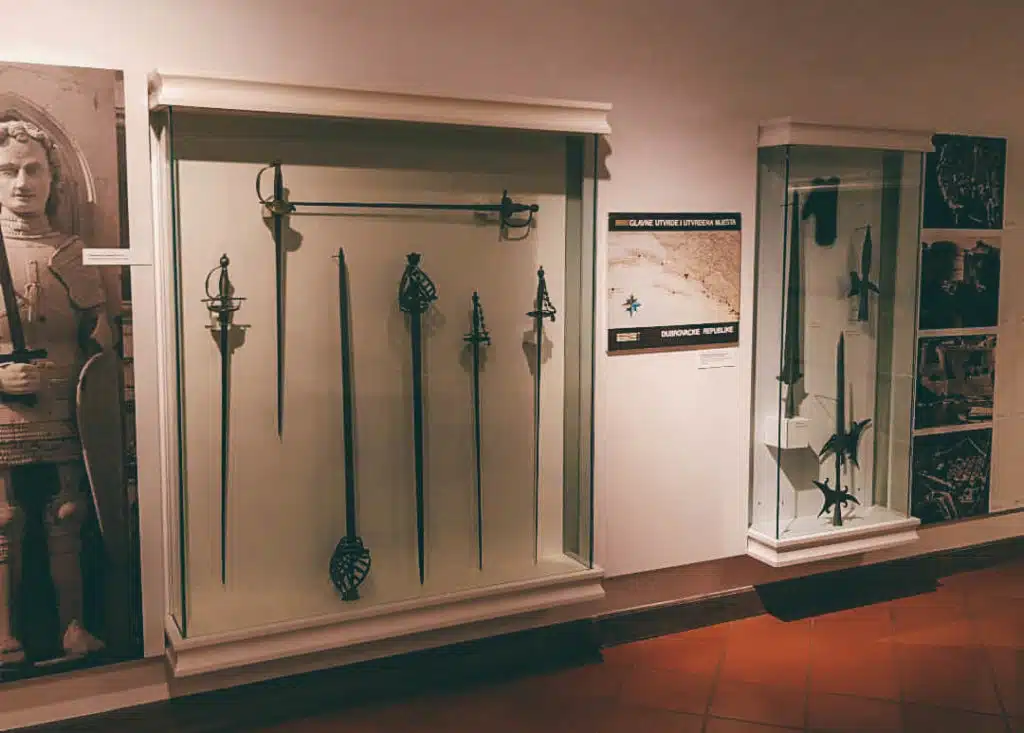
Are you looking for a dose of culture?
The museum's fifteen collections offer a wealth of art and history, featuring everything from paintings and printmaking to furniture and textiles, ceramics and metals, icons and glass, photographs and photographic materials, miscellanea and documents, postcards, weapons, and numismatics.
Here are the collections you can find in the Cultural Historical Museum:
The collection comprises 250 decorative art objects made of ceramics (faience, stone-ware, majolica) and some eighty china items. A group of 116 ceramic apothecaries' jars of different shape and size dating from the 16th to the 18th centuries represents the most significant part of the collection. They once belonged to the Domus Christi Pharmacy, a public pharmacy which was built in 1420 next to the poorhouse and hospital of the same name.
In 1761, the pharmacy became the ownership of Vokativo and Saric whose heirs sold this valuable collection to the town in 1914.The faience jars originate from potter's workshops scattered throughout Italy (Savona, Nove, Florence, Faenza, Naples, Palermo, Capodimonte), and were largely directly ordered for the above pharmacy. The majority of jars, therefore, bear a characteristic sign - a medallion with the figure of Jesus Christ who is carrying the cross (Gesu Portacroce).
In addition to these jars - arbarelle and brocche, there is a group of decorative vases that were made in the workshops in Castelli, Faenza, Naples, and Capodimonte. Painted in cheerful colours, these vases feature allegorical pictures or medallions of Hippocrates and Galen.
The apothecaries' collection is largely displayed in the southern wing of the Rector's Palace, in the rooms of the mezzanine floor. The display also included decorative vases from the well-know potter's workshops from Savona, Ginori and Delphi dating from the 18th century, as well as 19th-century Chinese and Japanese vases.
Due to their exceptional artistic and decorative value, these vases adorn the salons in the Museum's ambience display. Currently plans are being made to display tableware (tea, coffee and dinner services), as well as decorative items that were manufactured in the famous workshops and factories of Germany, France, Italy, Austria, and the Czech Republic, ranging in date from the 17th to the 19th centuries, in order to present a complete picture of this small community which has always had high appreciation of art.
The Dubrovnik Museum's collection of icons includes some three hundred valuable works ranging in date and style from the 17th to the 19th centuries. The collection reflects the heterogeneous stylistic development of this form of pictorial expression. One notices the intertwining of Byzantine influence and western reflections.
The works by native painters were largely influenced by eastern models and feature elements characteristic of the Veneto-Cretan school of icon painting. The later years, i.e. the end of the 18th and the beginning of the 19th centuries saw the appearance of the Boka Kotorska school of icon painting that was characterised by a decadent and crude manner of painting.
Appearing at this time were also works from the studios of the Russian school of icon painting that were based on series production. In 1977, the Croatian Museum Council decided to allocate to the Dubrovnik Museum a collection of icons that were up to then housed in the Dubrovnik Art Gallery. The collection was transferred in 1979.
The collection includes some 400 objects of exceptional value ranging in date from the 17th to the early 20th century, i.e. from the baroque to the Art Nouveau styles. These articles largely belong to applied arts and are made of precious or base metals (gold, silver, bronze, iron, brass, etc.) The great variety of forms and practical uses of these items bear witness to the fact that the citizens of Dubrovnik had a highly developed aesthetic sense which kept abreast of the European trends of the time.
Dubrovnik was one of Croatia's the most significant centres of the goldsmith's trade which was cultivated from the 13th well into the mid-20th centuries. During this whole period, the goldsmiths from Dubrovnik stamped their handicraft works with the old and prestigious hallmark of the former Dubrovnik Republic: The head of St. Blasius wearing a mitre.
What makes this collection particularly valuable and interesting are precisely these objects bearing the hallmark of the Dubrovnik Republic as well as the stamps of native goldsmiths. The items have largely been acquired or presented to the Museum, while some were confiscated. Their origin is related to Dubrovnik, but also to imports from neighbouring European countries, primarily Italy and Austria, and to a smaller extent from France, Spain, and Russia.
The collection can be divided into a number of smaller groups of items: A small collection of jewellery from the workshop of the Dubrovnik goldsmith Antun Linardovic, smaller collections of cutlery, tableware, candelabra, locks and keys, as well as other individual everyday utensils or decorative objects.
The collection of textiles includes some three hundred various items ranging in date from the 17th to the beginning of the 20th century. The majority of exhibits originate from Dubrovnik and have been acquired by the Museum. A smaller number of items were either presented or confiscated after the Second World War. Items of interest include official uniforms from the Dubrovnik Republic as well as outdoor patrician suits. The uniforms made of silk damask are a more simple work by local craftsmen, while the outdoor silk suits are richly embellished and probably originate from abroad.
These 18th-century items once belonged to patrician families and reflect the European fashion trends of the time. The collection also includes an 18th-century ship flag of the Dubrovnik Republic with the figure of St. Blasius painted on woollen cloth, as well as Dubrovnik lace of the 16th and 17th centuries.
In addition, there is a dozen of oriental carpets from the 18th and 19th centuries, some fifteen early 20th-century flags with the figure of St. Blasius, flags of choral and worker's societies dating from the turn of the century, parts of civil women's and men's dress and accessories from the early 20th century, several festive military uniforms of the Austro-Hungarian Empire, some seventy fragments of various silk fabrics largely dating back to the 18th century, including a number of 17th-century items, as well as a dozen of fans mostly dating from the 19th century.
The furniture collection which is housed in the Cultural History Museum includes around 250 pieces of furniture dating from the latest years of the Dubrovnik Republic and the 19th century. It features objects of various styles, forms and functions and illustrates the refined taste in home decor of the patrician and upper middle classes, who followed the general fashionable trends of the time.
Pieces of furniture were therefore frequently purchased in European cities and were then adapted to one's practical and aesthetic needs. They largely originate from south Italian or Venetian workshops of the 17th and 18th centuries and were made using the picturesque gold-plating techniques such as lacca veneziana or lacca povera, or the more discreet techniques of wood inlaying and encrustation, as well as various veneers.
The 19th-century collection includes works of Central European and Croatian origin. The period furniture of the Rector's Palace is not directly linked to the building whose historical furniture was either misappropriated or damaged in the course of centuries, but was collected from the old mansions, summer palaces or middle-class houses of Dubrovnik.
Exhibits of particular interest include a picturesque trumeau and a closet dating from the 18th century, which were made using the Venetian technique of the so-called "poor varnish" (lacca povera), which consists of graphic motifs that are being attached to surfaces painted in pastel colours. Worth mentioning are the seats in light pastel colours of the Venetian rococo, armchairs with gilding in the style of Louis XVI, heavy gold-plated consoles of the Italian baroque, inlaid chests of drawers dating from the late 17th century and originating from Northern Italy, a Maggiolini chest of drawers with delicate marquetry from the second half of the 18th century.
Especially valuable is a an elegant cabinet lavishly decorated with gilding and glass tempera paintings, manufactured in the late 17th century by the Italian Luca Giordano workshop. A separate group consists of 6 sedan-chairs dating from the 18th century which belonged to Dubrovnik patrician families. They are of Italian origin and are decorated with wood paintings and gold-plated carvings. The largest group of exhibits consists of some two hundred pieces of 19th-century furniture manufactured using the simpler veneer technique.
Although consisting of a limited number of items, the glassware collection covers a wide range of periods and styles. In recent years, this collection has been receiving special attention, with new acquisitions having been made and numerous exhibitions organised. The collection includes 120 glass items ranging in date from the 15th to the 20th century, largely of the Czech and Austrian origin, as well as works crafted in the Murano or Dubrovnik workshops.
The collection of photography and photographic material includes over 1,000 prints, largely by native authors who worked in Dubrovnik in the second half of the 19th c. or the first decades of the 20th c. Photographers who had their studios in Dubrovnik were Angelo Luzzena, Antonio Jellasca, Philipp Dengg, Silvino Mascarich, Tomaso Burato, Antun Miletic, Cesare Damiani, Josip Berner and Enrico Perich. Along with photographs, the collection also includes photograph-albums, glass negatives and photographic equipment (cameras, lenses).
In addition to a smaller number of sculptures, this collection includes several crucifixes, a number of old musical instruments as well as a collection of watches. Because the museum doesn't possess many of them, these items have been integrated into a single collection.The collection includes some fifty clocks and pocket watches dating from 17th to the 19th centuries.
These represent a separate section within the "miscellaneous" collection. They have been collected in the Dubrovnik area but are all of foreign origin, since in the 19th century there were only four clock-makers in the region who mostly did repairs.
Earlier there were clock-makers in Dubrovnik who were responsible for the maintenance of the public tower clock and when needed they also changed its mechanism (like Paskoje Baletin who in 1781 made a new mechanism for this clock that is today on view in the Sponza Palace). It has to be noted that the first public clock in Dubrovnik was put up as early as 1390 on the Rector's Palace tower bell (southeastern tower). In 1444, the new town clock-tower was built and the clock moved there.
However, the Rector's Palace retained its own clock which was moved below the tower on the atrium gallery. In the course of time the clockwork mechanisms were replaced by new ones, so that in addition to a Baletin clock the Museum now owns three old tower clockwork mechanisms made by local clock-makers in the same period.
The collection also includes mechanisms originating from Austria (Korner, Gstatter, Lazarus, Sacks, Kracher, Nigel), France (of Marshall Marmont), England (Buschman, Diary, Emery), Switzerland (Bautte), the Czech Republic, and Italy (the Roman notturno). Many of these are still working and have exquisite casings of various types.
There is also a number of tabernacle clocks dating from the 17th and 18th centuries, silver pocket watches from the same period, portal-clocks, a picture clock, wall clocks, longcase clocks, lanterns, travel watches and the like. The exhibits have either been acquired or presented as gifts by private collectors. Of special interest in this collection is a group of 10 musical instruments. In the days of the Republic, Dubrovnik could boast a very lively musical activity with such eminent composers as Luka Sorkocevic, Antonije Bertolini and others.
There was also a special Rector's Orchestra. The collection includes musical instruments made by local craftsmen (a harp by A. Bertolini), as well as those purchased from renowned European musical instrument makers (a piano by Anton Walter from Vienna or a violin made by Jospeh Guarneri from Italy).
Things to Know Before You Go
- History and art admirers should not miss visiting the Rector's Palace.
- It is necessary to purchase an admission ticket; we recommend Dubrovnik Pass.
- Wheelchair users are only able to access the ground floor.
How to Get There
Rector's Palace is between Saint Blaise's Church and the Cathedral on Pred Dvorom street in Old Town Dubrovnik. Walk to the end of Stradun street from Pile Gate, turn right at the bell tower, and continue towards the cathedral.
Pedestrians are the only ones allowed in Old Town, so if you are driving, park outside the city and walk or take a bus.
Details
| 📱 Phone | +385 20 321 497 |
| 📍 Address | Pred Dvorom 3 |
| 🌐 Website | www.dumus.hr |
| 🕒 Hours | 9:00-18:00 (09:00-16:00 in the winter). |
| 💵 Price | Single ticket - Adult €15 / Child €8 Multimuseum pass - Adult €20 / Child €8 |
If you love learning about the history of a place when you visit, the Cultural-historical museum is the perfect attraction for you! This museum is full of fascinating information about Dubrovnik's past. So be sure to add it to your itinerary and spend some time discovering all that this incredible city has to offer.
GOT QUESTIONS?
What is the Rector's palace Dubrovnik entrance fee?
Dubrovnik Pass includes the entrance fee to the Rector's Palace; otherwise, you can buy a single ticket. The entrance fee for adults is €15, while students and children pay €8. Daily hours of the palace and museum are 9:00-18:00 (16:00 in the winter).
There is no admission to the museums in Dubrovnik on Wednesdays, Christmas Day, New Year's Eve, and St Blaise's day.
Is a visit to the Rector's Palace worth it?
Dubrovnik Pass is not just for walking along the walls, but also for accessing a few different locations. This was by far the best Dubrovnik museum. It is probably the only attraction would say is worth paying tickets if you don't have the Pass. The architecture is lovely, and there are many rooms filled with interesting displays.
